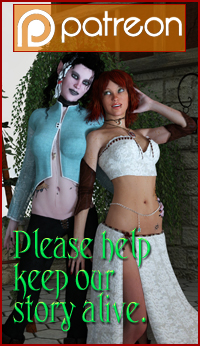Heya friends! Happy Holidays! I am working very hard on the next page. Unfortunately, Adobe somehow caught on to the fact that I have been using Photoshop license free for about 15 years and they have shut me down. So, instead of paying their insane monthly fee that they will use to continue to invest in the evils of AI image theft, I am learning a new freeware photo editing software called Gimp. I figured after being basically an expert on Photoshop for so long I’d be able to pick up Gimp pretty quickly, but sadly this is not true. I am trying my best. New page soon! Spoiler – this is the last page in this chapter. 😀
Anyone who donates $20 or more will receive a personalized hi-resolution Thank You note from their favorite character.
Recent Comments
- Stunt Wookie on Bk1: Ch11: Pg16
- Oldarmourer on Bk1: Ch11: Pg16
- Guesticules on Bk1: Ch11: Pg16
- Chaucer59 on Bk1: Ch11: Pg16
- Feori on Bk1: Ch11: Pg16
- Chaucer59 on Bk1: Ch11: Pg16
- Oldarmourer on Bk1: Ch11: Pg16
- Oldarmourer on Bk1: Ch11: Pg16
- Aname on Bk1: Ch11: Pg16
- Aname on Bk1: Ch11: Pg16
Visitor Statistics
- 2
- 421
- 108
- 13,177
- 62,971
- 810,268
- 1,268
- 0


I am using Gimp now for some years. It is not as intuitive as Photoshop, but it basically has all the features of Photoshop, and meanwhile I prefer it although I also bought a Photoshop Elements license, too.
Good luck! I’m told GIMP is not as capable as Photoshop, but in my experience it can do most of the things the average consumer uses PS for. No idea how well it will work for a webcomic artist.
Take your time. GIMP is VERY good, but very different. IT is worth the wait ( for most of us) to wait to see your work when you are happy with it. 😉
Looking forward to seeing if there will be a cast change with GIMP production company taking over from Photoshop 🙂
No changes on that end. 😀
No auditioning for roles? That’s good 🙂
I think I’m going back to Photoshop. I’ve run into some problems in Gimp that I am not sure can be addressed.
We are back up and running! New page will be out tomorrow night. I am going to try very hard to get content out more quickly!
I’m a long-time GIMP user; as a programmer, I find it much more intuitive than Photoshop. Maybe it’s too late(I’ve been sick as well as busy with the holiday), but I’d be happy to answer any questions you have about it 🙂
Thank you. Right off the bat what turned me off was the pixelated edges when using stroke on a selection. That is key to how I do the speech bubbles and it just looked like crap. Most other things were ok – like I could get the hang of it eventually – but the Roblox level res on stroke was a deal breaker.
Ah, okay, that’s a setting. There should be both antialiasing and feathering as options for the brush. That’s definitely something I had to get used to.
Thank you. I’ll take a look at that. I know antialiasing was on – I’ll check on feathering.
There’s three things to know about the “blocky edges.” First, in the same dialog where you ‘stroke selection’ (or the control box where you configure the brush you’re using) you can select “feather” or “anti-alias” to soften the edges in different ways.
Second, this works best when drawing on layers that are transparent. If you “anti-alias” a black line on a white background (or whatever) and try to select the resulting line, you’re going to get ‘sparklies’ along the edges where the blend from black to white is too light for whatever you’re trying to see on lower layers, so the line stands out in a weird way.
Third, you can color map from a given color to the alpha channel, meaning you can ‘erase’ a given color from a layer leaving transparency in its place – and the result is transparent to the same degree the color was present, transforming the image into something like a transparency. In the above example, if you did it wrong you could map white to the alpha channel and get your line anti-aliased into transparency instead of into white. But this can have much more versatile effects in photomanipulation or art.
GIMP has a steep learning curve, but people who’ve been using it a long time (And that’s a self-selected sample, so the interpretation of this is questionable) consider it to be better than Photoshop.